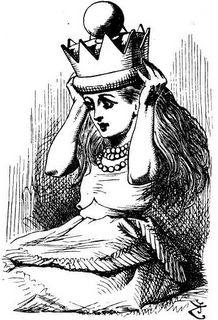
The awesome Annie, of
Blogdorf Goodman, has challenged a few friends to post reviews of the mascaras we've used, and also to branch out this month and try new ones. (And thank you
Katie for the great logo!) I don't know how many reviews I'll end up writing, but I'm always on the lookout for the perfect mascara. I'm a makeup minimalist - most days, it's just translucent powder, mascara, and some sort of lippie. If I had to lose two of those items, mascara is the one I'd keep - can't go without it!
Before I write any actual reviews, I'd like to start with a little history, a few observations about mascara in general. First, I have to say that,
from brand to brand, high-end or low, mascara seems to differ in quality the least of any cosmetic, in my opinion. This is why I seldom think it worth it to spend mucho dinero on it. There are as many really good, cheap mascaras out there as there are expensive ones, if you consider the formula and brush only, and not fancy packaging. This uniformity is both a blessing and a curse: Blessing, because I know I can get a more-than-decent mascara for very little money; curse, because I've come to believe that, no matter how much I'm willing to spend on mascara, there are certain shortcomings I have to put up with. But hope springs eternal - thus the purpose of this May Mascara Madness!
Second, it seems to me that mascaras have changed the least
over time than any other beauty product. The first mascara I ever used, 30 years ago, was Maybelline Great Lash. This is the one in the iconic pink and green tube - it has been an industry leader ever since its launch in 1971, and the formula remains unchanged. Maybelline t
outs it as "America's #1 best-selling cosmetic product," reporting that a tube sells every 1.9 seconds. They claim their original mascara formula was a concoction of petroleum jelly and coaldust, created by a chemist in 1913 to help his sister wow her reluctant beau. Apparently it worked, as the sister & beau were married in 1914! While we can now safely assume there's no coaldust in our mascara, petrolatum still features high on the ingredient list in many brands. (By the way, the first mascaras were only available in cake form - the user had to wet a small brush, swirl it over the cake, and apply to the lashes. The first "wand" mascara was launched by Helena Rubinstein in 1957.) In 1996, Maybelline was acquired by cosmetics giant L'Oreal, leading to presumably even less diversity in the mascara formulae on the market.
For the most part, modern mascara formulae are very similar. Despite the advertising hype, there are no miracle ingredients that make one brand stand out from another. All contain water, waxes (to thicken lashes), film-forming ingredients (to make the product cling to the lashes), colorants, and preservatives. Some mascaras also contain fibers - usually nylon or rayon - that are supposed to bind to the lashes to lengthen them. These fibers can be problematic for contact lens wearers. The biggest difference between mascara formulae is regular vs. waterproof. Although some brands tout special formulae to curl, lengthen, thicken, define, volumize, etc., these effects are primarily achieved through the use of different types of brushes/combs. The success of Max Factor's recent release, Lash Perfection, for example, is entirely based on the innovative soft brush.
Okay, enough history. I will try to get to some reviews tomorrow. In the meantime, please browse the following blogs for more Mascara Madness!
http://www.beautifulmakeupsearch.com/blog2/http://beautyaddict.blogspot.com/http://blend10.blogspot.com/http://thedailyobsession.wordpress.com/http://beautydiary.blogspot.com/http://www.ladybuglife.blogspot.com/http://monkeyposh.blogspot.com/http://thenonblonde.blogspot.com/http://scentzilla.com/http://victoriasown.blogspot.com/
 My most recent mascara purchase was at Ulta, the cosmetics superstore. Ulta entered the market here only a few months ago, and I've tried a few of their store-brand cosmetics, hoping they would be on a par with Sephora. Eh. Let me tell you about the mascara...
My most recent mascara purchase was at Ulta, the cosmetics superstore. Ulta entered the market here only a few months ago, and I've tried a few of their store-brand cosmetics, hoping they would be on a par with Sephora. Eh. Let me tell you about the mascara... basis for complaint. But still. It's got a standard-shape brush with fairly stiff bristles - not a lot of give. The stiff bristles should assist in the curling technique, but it doesn't work particularly well, and here's why: The mascara formula itself is dry, dry, dry! It's not fluid enough to coat the lashes and make them bendable. I almost returned it to the store, thinking I'd gotten an old tube, but I talked to a friend who's tried it and she had the same experience. So unless we both got bad tubes, this is just a really dry formula. Upon application, it makes my lashes look and feel rather scrubby - yes, they are thicker, but in a kind of "gunked up" way. The surface is not smooth. I find I need to apply a couple of coats to get any added length (not something I normally do - I'm a one-coat-n-go gal) , and then it's hard to drag the brush back through my lashes because of the texture of the first coat.
basis for complaint. But still. It's got a standard-shape brush with fairly stiff bristles - not a lot of give. The stiff bristles should assist in the curling technique, but it doesn't work particularly well, and here's why: The mascara formula itself is dry, dry, dry! It's not fluid enough to coat the lashes and make them bendable. I almost returned it to the store, thinking I'd gotten an old tube, but I talked to a friend who's tried it and she had the same experience. So unless we both got bad tubes, this is just a really dry formula. Upon application, it makes my lashes look and feel rather scrubby - yes, they are thicker, but in a kind of "gunked up" way. The surface is not smooth. I find I need to apply a couple of coats to get any added length (not something I normally do - I'm a one-coat-n-go gal) , and then it's hard to drag the brush back through my lashes because of the texture of the first coat.





